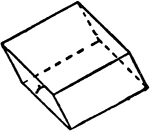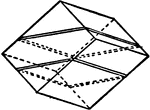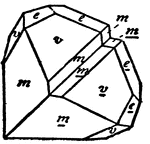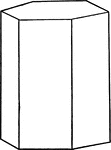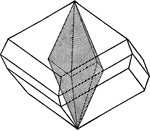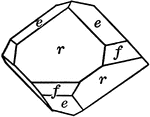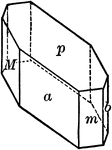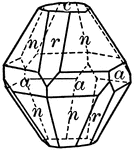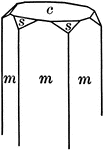This science ClipArt gallery offers 324 illustrations of crystals of numerous minerals. These crystalline minerals are created through natural processes, and so often times there are numerous crystal shapes for any given mineral (polycrystalline materials).
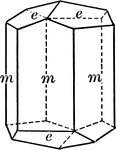
Calcite
"Hexagonal-rhombohedral. Crystals are very varied in habitat, often highly complex. Over 300 different…

Calcite
"Hexagonal-rhombohedral. Crystals are very varied in habitat, often highly complex. Over 300 different…

Calcite
"Hexagonal-rhombohedral. Crystals are very varied in habitat, often highly complex. Over 300 different…
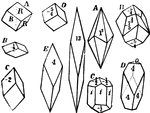
Calcite Crystals
This illustration shows calcite crystals. They are hexagonal-rhombohedral, though actual calcite rhombohedrons…

Calcium Hyposulphite
This figure shows the combination of forms on calcium hyposulphite (CaS_2_O_3_ + 6 aq). If we assume…

Calcium Phosphate, Apatite
This crystal of Calcium Phosphate, Apatite, represents a complex combination of hexagonal hemihedral…

Calcium-Magnesium Metasilicate
Also known as Diopside, this crystal exhibits symbols whose forms are: (c), (b), (a), (m), (o), and…

Cassiterite
"Tetragonal. Common forms are prisms and pyramids of first and second orders." — Ford, 1912
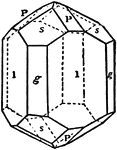
Cassiterite
Cassiterite is a tin oxide mineral, SnO2. It is generally opaque but is translucent in thin crystals.…

Cassiterite
Cassiterite is a tin oxide mineral, SnO2. It is generally opaque but is translucent in thin crystals.…
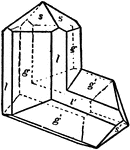
Cassiterite
Cassiterite is a tin oxide mineral, SnO2. It is generally opaque but is translucent in thin crystals.…
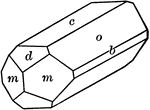
Celestite
"Orthorhombic. Crystals resemble closely those of barite. Commonly tabular parallel to the base or prismatic…
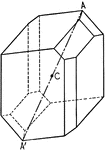
Symmetry center
"A crystal has a center of symmetry if an imaginary line is passed from some point on its surface through…

Cerussite
"Habit varied and crystal show many forms. Crystals often tabular parallel to brachypinacoid." —…

Cerussite
In the orthorhombic system, tabular crystals of lead carbonite (cerussite), bounded by the forms ∞P∞̆,…
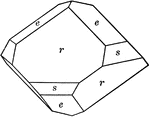
Chabazite
"Hexagonal-rhombohedral. Common form is the simple rhombohedron, r, having nearly cubic angles. May…

Chalcocite
"Orthorhombic. Usually in small tabular crystals with hexagonal outline. Striated parallel to the brachy-axis."…
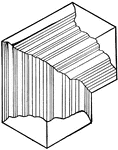
Chalcocite
"Orthorhombic. Usually in small tabular crystals with hexagonal outline. Striated parallel to the brachy-axis.…
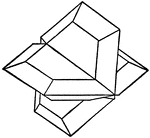
Chalcocite
The Copper Sulphide, Chalcocite, forms three kinds of twins symmetrical to ∞P, {110}, to 4/3P∞̆,…
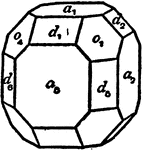
Clinographic Drawing of a Cubic Crystal
"A drawing of a crystal showing a combination of the cube, octahedron and rhombic dodecahedron is shown,…
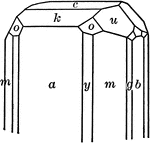
Columbite
"Orthohombic. Habit of crystals is short prismatic; often in square prisms because of prominent development…

Compound Twinning
This figure shows an example of Compound Twinning, where two orthoclase twins are twinned in parallel…
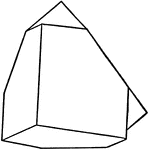
Copper Contact Twin
This figure shows a contact twin of copper, one of the three simplest isometric holohedrons according…

Copper Silicate Showing Rhombohedral Tetartohedrism In the Hexagonal System
This is a crystal of Copper Silicate (Dioptase) with a rhombohedron of the third order, (s), in combination…
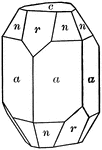
Corundum
"Hexagonal-rhombohedral. Crystals usually prismatic in habit or tapering hexagonal pyramids." —…

Corundum
"Hexagonal-rhombohedral. Crystals usually prismatic in habit or tapering hexagonal pyramids." —…
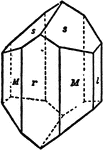
Crystal of Augite
"...represents a crystal of augite bounded by th clino-pinacoid, the ortho-pinacoid, a prism, and a…
!["Here there is only a [center] of symmetry. All the forms are pina-coids, each consisting of only two paarallel faces." -The Encyclopedia Britannica 1910](https://etc.usf.edu/clipart/35500/35580/axinite_35580_mth.gif)
Crystal of Axinite
"Here there is only a [center] of symmetry. All the forms are pina-coids, each consisting of only two…
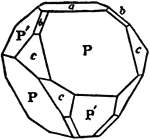
Crystal of Chalcopyrite
"...a combination of two bisphenoids (P and P'), two bipyramids of the second order (b and c), and the…

Crystal of Dioptase
"...represents a crystal of dioptase with the fundamental rhombohedron (r) and the hexagonal prism of…

Crystal of Fergusonite
"...a combination of tetragonal prism of the first order with a tetragonal bipyramid of the third order…

Crystal of Hemmorphite
"...a combination of the brachy-pinacoid and a prism, with the pedion, two brachy-domes and two marco-domes…
![This figure represents a crystal of iron pyrite showing representatives of all the forms of the isometric system except the rhombic dodecahedron: ∞O∞ {100} (P); O, {111} (d); [∞O2/2], π{102} (e); [4O2/2], π{214} (s); 2O2, {211} (o); and 3O, {133} (t). It is shortened in the direction of one of the principal axes, which, together with the fact that only two of the three faces belonging to the forms s, o, and t are developed in each octant, gives to it a decidedly orthorhombic habit.](https://etc.usf.edu/clipart/86800/86858/86858_crystal-of-iron-pyrite-showing-representatives_mth.gif)
Crystal of Iron Pyrite Showing Representatives of All the Forms of the Isometric System
This figure represents a crystal of iron pyrite showing representatives of all the forms of the isometric…

Crystal of Tourmaline
"...represents a crystal of tourmaline wit the trigonal prism, hexagonal prism, and a trigonal pyramid…

Crystal of Zircon (actual)
"...shows the actual shape of a crystal of ziron from Ceylon" -The Encyclopedia Britannica 1910
!["...the ideally developed form [of a zircon crystal]. The crystal is a combination of five simple forms: two tetragonal prisms, two tetragonal bipyramids, and one ditetragonal bipyramid." -The Encyclopedia Britannica 1910](https://etc.usf.edu/clipart/35600/35603/zircon2_35603_mth.gif)
Crystal of Zircon (ideal)
"...the ideally developed form [of a zircon crystal]. The crystal is a combination of five simple forms:…
